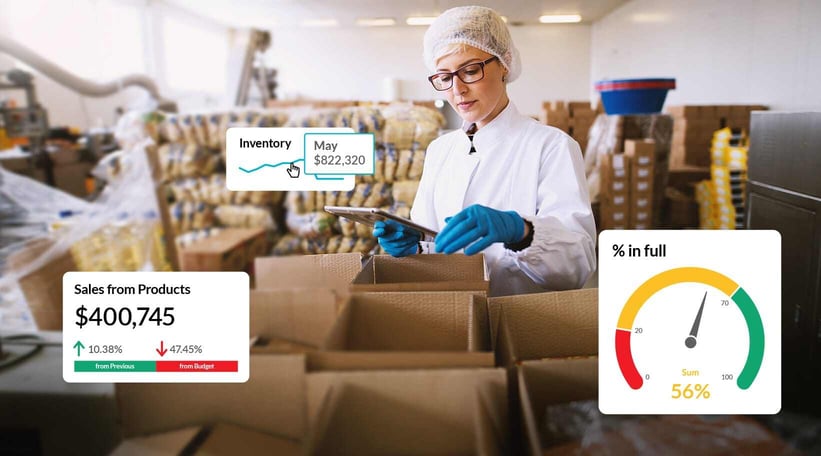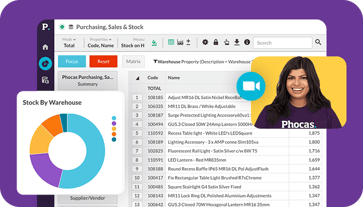Why data analytics in industry matters
Having the right data analytics tool is essential for making smart business decisions. But generic solutions don’t always fit a company’s unique needs. With cloud technology, industry-specific analytics tools—also known as vertical software-as-a service (SaaS)—are becoming increasingly popular. These tailored solutions help businesses in specific industries get better insights, optimize operations and increase their competitive advantage.
The rise of industry-specific data analytics
Many businesses still use traditional software for data analytics, but newer, cloud-based vertical SaaS tools offer better, customized solutions. The manufacturing industry as well as wholesale, retail, and construction now have access to analytics software designed just for them that uses advanced analytics, automation and predictive modeling to extract the insights each industry needs to grow, expand and improve.
Generic analytics tools often fall short because they provide broad, one-size-fits-all insights that don’t align with industry-specific needs. They often lack the ability to handle production nuances, industry regulations and specialized KPIs. For example, a wholesale distributor might struggle with managing vast amounts of inventory across multiple locations. A generic solution might provide basic sales reports, but an industry-specific tool could use machine learning algorithms to optimize inventory levels, prevent stockouts and predict demand fluctuations. These tailored capabilities allow businesses to unlock deeper data-driven insights and make more informed decisions.
Before cloud computing, companies had to install software on individual computers and maintain expensive servers. Data was only accessible from specific locations. Now, businesses can store vast amounts of data in the cloud, access real-time data from anywhere, and leverage data-driven insights to improve decision-making.
And, from a financial perspective, businesses don’t have to worry about the costs and hassle of maintaining servers or upgrading software. With SaaS, businesses get real-time access to their data, making it easier to track performance, eliminate bottlenecks, and make data-driven decisions. Industry-specific solutions have become popular because they provide highly relevant, actionable insights tailored to a company’s needs.
How big data helps businesses
Big data is growing at an exponential rate, with businesses generating more unstructured data than ever before. Without the right tools, managing large data sets can be overwhelming. Industry-specific SaaS solutions help manage this flood of information by collecting, organizing and analyzing data from different sources like IoT devices in manufacturing, social media listening in retail and supply chains’ movements.
BI tools simplify data analysis by automating data collection, organizing unstructured data, and visualizing complex insights through dashboards and reports. Instead of manually sifting through spreadsheets, decision-makers can turn raw data into actionable insights. What this means in practice is a faster, more efficient way to uncover market trends so they can help businesses improve operational efficiency and enhance the overall customer experience.
Here are some examples:
-
Retailers can use big data analytics to track customer behavior and optimize pricing
-
Manufacturers can use predictive maintenance analysis to reduce machine downtime and improve product quality
-
Distributors can leverage prescriptive analytics for demand planning and inventory metrics for risk management across the warehouse.
Managing data the right way
To get useful insights from data, businesses need to manage it properly. Without good data management, you risk using outdated or inaccurate information, which can lead to disruptions and inefficiencies.
Vertical SaaS tools help businesses keep their data organized, secure and easy to access by consolidating ERP and other data sources into a one centralized platform. This makes it easy and secure for all stakeholders to access the latest insights – wherever and whenever they need it. The system follows specific data engineering processes such as mapping and validation to simplify the structure and storage of data into a single data warehouse. Then, it works on the data visualization, turning large amounts of data into reports and dashboards that are continuously updated whenever source data changes. This means users are always working with accurate and current information when making business decisions.
Predicting trends with forecasting
Forecasting helps businesses prepare for the future by predicting demand, resource needs and financial performance. Industry-specific analytics solutions use historical data, machine learning algorithms, and optimization techniques to generate accurate forecasts. Phocas’ Budgets and Forecasts feature allows companies to set financial targets, track progress and refine their planning.
For example, HVAC companies experience seasonal demand shifts so scenario planning can help them ensure they have enough A/C parts in stock in preparation for an influx of work in the summer. Similarly, manufacturers can use forecasting for raw material management.
Taking action with prescriptive analytics
While forecasting predicts trends, prescriptive analytics goes a step further by recommending specific actions. Vertical SaaS tools use artificial intelligence (AI) to suggest the best course of action based on data insights.
Phocas is enhancing its AI capabilities to improve prescriptive analytics. Soon, users will be able to log into Phocas and receive automated recommendations on their next steps. The system will analyze updated customer data and suggest who to call and what to say based on recent sales trends. By doing the analysis for the user, Phocas will help businesses prioritize their tasks more effectively, making decision-making faster and more data-driven.
For example, an auto parts distributor might get recommendations on which products to promote based on customer purchasing patterns. A construction supplier could receive pricing strategy suggestions based on market demand. By using prescriptive analytics, businesses can enhance customer satisfaction, streamline human resources initiatives, and proactively manage risk.
How different industries use vertical SaaS
Vertical SaaS tools are customized for specific industries with the purpose of helping, businesses use their data to solve problems and find new opportunities.
For example, trade and construction companies need to manage inventory carefully to avoid stock shortages or excess supplies. With the right data analytics, these businesses can optimize inventory levels to meet seasonal demand without overstocking and predictive models can be used to help anticipate future needs, reduce inefficiencies and increase overall profitability.
Phocas customers in the HVAC and plumbing industries have reduced supply chain inefficiencies by 20-30% by using more detailed data analysis. Some have even discovered new cross-sell opportunities, increasing revenue by six figures within just a few months.

In the food and beverage industry, restaurants rely on descriptive analytics to track KPIs like food costs and service quality. These insights inform menu profitability and pricing strategies.
Ongoing improvements and long-term benefits
One major advantage of vertical SaaS tools is that they’re constantly updated with new features (which should come at no extra cost to your business). Many providers even allow businesses to test new features before they’re officially released. Over the years, we’ve worked closely with our clients across automotive, building, retail, manufacturing, and wholesale to develop tailored industry-specific solutions that go beyond standard, off-the-shelf software. This has helped Phocas understand the world in which manufacturers, distributors and retailers operate so we can tailor features to better manage tasks like production efficiency and supply chain management.
Get more out of your data with BI and FP&A software
With BI and FP&A software (like Phocas), you get the best of business intelligence and financial planning and analytics into one platform. The software integrates with over 30 ERP systems, making it easy for your business to access valuable insights from your existing data that will help your business improve profitability, streamline operations, and identify market trends that impact your bottom line. Anyone, including non-technical users, can go from high-level overviews to in-depth transaction details in just a few clicks using easy-to-read dashboards and detailed reports for quick and usable insights.


Empowering businesses with intuitive data analytics, driving informed decisions for growth and profitability. We make people feel good about data.
Related blog posts

DIFOT (Delivered In-Full, On-Time) or OTIF (On-Time In-Full) is a fundamental KPI when analyzing the performance of your supply chain. The main goal is to get your customers the products they need, when they need them, in the quantity they ordered. DIFOT measures how successful your business is at achieving this objective and identifies procurement problems and supplier reliability.
Read more
Picture a football coach preparing for the big game. He watches game‑tape, studying player metrics, analyzing every play and using real‑time stats to inform strategy. That’s exactly how sales managers and sales leaders should approach their coaching program—with a data‑driven approach.
Read more
Sales professionals operate in face-paced environments with savvy customers who have a lot of choice. Whether you're in B2B sales or working with consumers, the sales process is challenging with longer sales cycles, more decision-makers and higher expectations for follow-up and advice. To stay competitive, sales reps and sales teams need the best sales tools to reduce administrative tasks and improve sales team performance.
Read more
“Free BI tools trial, business analytics software for free, free BI reporting with AI-powered insights”– these offers are tempting business people all the time especially as new open-source players enter the market and want cut-through.
Read moreBrowse by category

Find out how our platform gives you the visibility you need to get more done.
Get your demo today